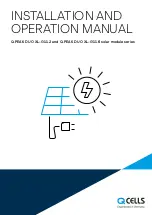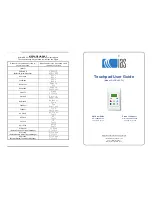
12
General Installation Manual
WIRING
GENERAL
• All wiring should be done in
accordance with applicable
electrical codes.
• Wiring methods should be in
accordance with the NEC in USA or
CEC in Canada.
• All wiring should be done by a
qualified, licensed professional.
• Wiring should be protected to help
ensure personal safety and to
prevent its damage.
• Please connect each cable after
confirming the polarity of it is
correct.
• Connectors between modules must
be inserted until they click.
• When connecting the connectors,
please make sure that foreign
matter such as water, sand and so
on do not get inside the connector.
Also, please keep in mind that
if you leave the connector in a
nonconnected state for a long
period of time, contamination of
foreign matter is likely to occur.
• If an extreme load is applied to
the cable, the cables may come
off the junction box body or the
connectors.
• Please connect so that a strong
load is not applied to the cable.
• Do not disconnect terminals while
modules generate electricity and
connect electrical load to avoid the
hazard of electrical shock.
• Cable conduits should be used
in locations where the wiring is
inaccessible to children or small
animals.
• Please contact your Panasonic
Authorized Representative
with questions regarding other
electrical connections if needed.
MODULE WIRING
• All modules connected in series
should be of the same model
number and/or type.
• The maximum number of modules
in a string can be calculated by
dividing the maximum system
voltage of the module by its
VOC accounting for the lowest
ambient temperature at site, e.g.:
for a 1000V system, if the lowest
ambient temperature is 15°C, the
module has a VOC of 44.3 V and a
temperature coefficient of VOC of
-0.24%/°C, the maximum modules
per string is 22 (ΔT°C = 25° - 15° =
10°; 10° x 0.24 = 2.4%; 44.3 + 2.4%
= 45.4; 1000 V / 45.4 = 22.0, so a
total of 22 modules or 976 V).
• Qualified system designers can
make exact calculations that
account for specific project
requirements and site conditions.
• If modules will be used in an
“offgrid” system, a compatible
MPPT (Maximum Power Point
Tracking) charge controller is
required. Especially charge battery
can not be used without MPPT.
• These modules contain factory
installed bypass diodes. If these
modules are incorrectly connected
to each other, the bypass diodes,
cable, or junction box may be
damaged.
• Do not connect modules in parallel
without using connection devices
that connect to appropriate FUSE
for each series string or each
module.
ARRAY WIRING
• The term “array” is used to
describe the assembly of several
modules on a support structure
with associated wiring.
• When installing a PV array, the
system design must be completed
with reference to the module
electrical specifications for proper
selection of inverters, fuses,
breakers, charging controllers,
batteries and other storage
devices. In particular, as the
temperature characteristic of
the PV module, the voltage value
rises on the low temperature side.
Consider the lowest temperature
in the area where the system is
installed and select the equipment
so that it does not exceed the rated
voltage of the equipment.
• Use copper wire which is insulated
to withstand the maximum possible
system open circuit voltage. For
applications where wire conduits
are used, follow the applicable
codes for outdoor installation
of wires in conduits. Minimum
diameter of wire conduit is 4
mm2. The temperature rating
of conductor is -40ºF(-40ºC) to
194ºF(90ºC).
• In order to avoid submerging
cables and connectors in the water,
cables must be fixed either to the
module frame using cable fixing
holes or to the mounting structure.
Also, if the cable is not secured, a
force may be applied to the cable
from the outside, and the module
may be damaged.
• Do not insert PV cable between
back side and mounting structure
rail. When snow weight is applied
to the module, load may be applied
to the cable.
• Verify that all fittings are properly
installed to protect cables against
damage and prevent moisture
intrusion.
• Check your local codes for
requirements




































